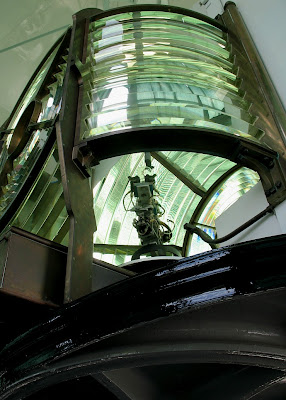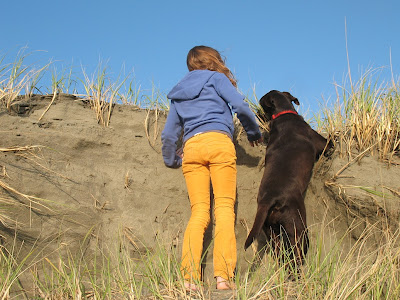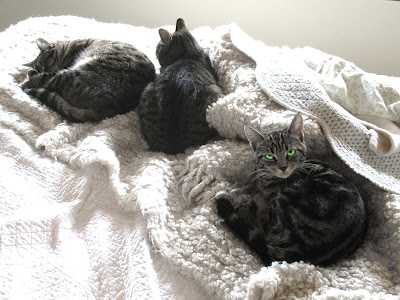31.5.10
Memorial Day
I'm refraining from posting a photo today, to commemorate not the soldiers who have died in war but the millions of civilian women, children, and men who have died because they got in the way of dogma.
28.5.10
Sepia Bureaucracy
Crawling back through the centuries via offical documents.
1893: The Parcel Map

This Wayne County, Michigan, parcel map shows the land holdings of my great-grandfather John Bentley, as well as those of familes who would marry into the Bentleys (and vice versa), including Chillson, Rohde, and Bredin. Many of these names are familiar to me through the humorous autobiographical poems of my dad's, as his school friends and neighbors.
1865: The Ship's Log

Great-great-grandfather William Bredin arrives from Ballymagroarty, Ireland, with his family.
The Census

Great-great grandfather George Bentley's family appears in the Livonia, Michigan, census. In nine years, son John will marry immigrant Maggie Bredin.
1843: The Deed

Great-great-grandfather Nelson had moved about 1835 to Livonia from New York, preceding his brothers and parents. (His forebears had arrived in Rhode Island in the mid-1600s following the Puritans.) George met his wife-to-be, Elizabeth Blindberry (from Ireland), in Detroit, and purchased this land west of Detroit.
Now the paperwork fades away for a couple of long centuries...until...
The Will

In 2005 my son and I visited Elstow and Ampthill, Bedfordshire -- the ancestral home of my Bentleys (at least as far back as anyone can trace via definitive records). In the County Archives I amazingly managed to find the Last Will of Mary Bentley (d. 1632), grandmother of the famous religious writer John Bunyan. Here's a copy.
Dictionary of National Biography,” London: Smith, Elder, & Co,, 1886:
“The will of John Bunyan's maternal grandmother, Mary Bentley (d. 1632), with its "Dutch-like picture of an Elstow cottage interior two hundred and fifty years ago," proves (J. Brown, Biography of John Bunyan, to which we are indebted for all these family details) that his mother "came not of the very squalid poor, but of people who, though humble in station, were yet decent and worthy in their ways."
In the name of God, Amen. This 27th day of June 1632 I, Mary Bentley,
of Elvestoe (Elstow) in the county of Bedford, widow but being sick in body but of perfect mind and memory I thank my heavenly father. I do make this my last will and testament in manner and form following that is to say first I bequeathe my soul unto almightyGod my Maker in whom I hope to be saved through Jesus Christ my Savior and my Body be buried in the churchyard of Elstow aforesaid.
Item, I give and bequeath to John Bentley, my son one brass pot, one little table, and all painted cloths about the house and the standing bed in the loft.
Item, I give to my daughter Margaret the joined stool in the chamber and my little [???]
Item, I give to my daughter Rosse the joined form in the chamber and a hogshead and the tumblestole.
Item, I give to my daughter Elizabeth the little kettle and the big platter, a flaxin sheet and a flaxin pillowbeare, a trundle bed and a copper in the chamber and the [???].
Item, I give to my daughter Annie my best [???], my best cuffe, my gowne, my best petticoat, the presse in the chamber, the best bolster and blanket and the coffer above and the kettle, the mortar and pestle, platter, and the other trundle bed, a harden sheet and pillow beare.
Item, all my other goods and chattels whatsoever I unbequeathed I give and bequeath to my daughter Mary whom I appointed to be soul executrix of this my last Will and testament whom I will se honestly buried and my burial discharged in witness whereof I have hereunto set my and and seal the day and year above written.
In presence of John Welle, Clerk The Mark of Mary Bentley The Mark of Margerie Jaques, widow (Latin) The Will proved Oct. 6, 1632
More of my genealogy, FWIW
1893: The Parcel Map

This Wayne County, Michigan, parcel map shows the land holdings of my great-grandfather John Bentley, as well as those of familes who would marry into the Bentleys (and vice versa), including Chillson, Rohde, and Bredin. Many of these names are familiar to me through the humorous autobiographical poems of my dad's, as his school friends and neighbors.
1865: The Ship's Log

Great-great-grandfather William Bredin arrives from Ballymagroarty, Ireland, with his family.
The Census

Great-great grandfather George Bentley's family appears in the Livonia, Michigan, census. In nine years, son John will marry immigrant Maggie Bredin.
1843: The Deed

Great-great-grandfather Nelson had moved about 1835 to Livonia from New York, preceding his brothers and parents. (His forebears had arrived in Rhode Island in the mid-1600s following the Puritans.) George met his wife-to-be, Elizabeth Blindberry (from Ireland), in Detroit, and purchased this land west of Detroit.
Now the paperwork fades away for a couple of long centuries...until...
The Will

In 2005 my son and I visited Elstow and Ampthill, Bedfordshire -- the ancestral home of my Bentleys (at least as far back as anyone can trace via definitive records). In the County Archives I amazingly managed to find the Last Will of Mary Bentley (d. 1632), grandmother of the famous religious writer John Bunyan. Here's a copy.
Dictionary of National Biography,” London: Smith, Elder, & Co,, 1886:
“The will of John Bunyan's maternal grandmother, Mary Bentley (d. 1632), with its "Dutch-like picture of an Elstow cottage interior two hundred and fifty years ago," proves (J. Brown, Biography of John Bunyan, to which we are indebted for all these family details) that his mother "came not of the very squalid poor, but of people who, though humble in station, were yet decent and worthy in their ways."
In the name of God, Amen. This 27th day of June 1632 I, Mary Bentley,
of Elvestoe (Elstow) in the county of Bedford, widow but being sick in body but of perfect mind and memory I thank my heavenly father. I do make this my last will and testament in manner and form following that is to say first I bequeathe my soul unto almightyGod my Maker in whom I hope to be saved through Jesus Christ my Savior and my Body be buried in the churchyard of Elstow aforesaid.
Item, I give and bequeath to John Bentley, my son one brass pot, one little table, and all painted cloths about the house and the standing bed in the loft.
Item, I give to my daughter Margaret the joined stool in the chamber and my little [???]
Item, I give to my daughter Rosse the joined form in the chamber and a hogshead and the tumblestole.
Item, I give to my daughter Elizabeth the little kettle and the big platter, a flaxin sheet and a flaxin pillowbeare, a trundle bed and a copper in the chamber and the [???].
Item, I give to my daughter Annie my best [???], my best cuffe, my gowne, my best petticoat, the presse in the chamber, the best bolster and blanket and the coffer above and the kettle, the mortar and pestle, platter, and the other trundle bed, a harden sheet and pillow beare.
Item, all my other goods and chattels whatsoever I unbequeathed I give and bequeath to my daughter Mary whom I appointed to be soul executrix of this my last Will and testament whom I will se honestly buried and my burial discharged in witness whereof I have hereunto set my and and seal the day and year above written.
In presence of John Welle, Clerk The Mark of Mary Bentley The Mark of Margerie Jaques, widow (Latin) The Will proved Oct. 6, 1632
More of my genealogy, FWIW
24.5.10
Watershed
Took a tour of some local watersheds with Sustainable Bellevue and People for Puget Sound.
We certainly place a lot of obstacles in our streams' way.
Part of Kelsey Creek is hidden in a culvert running underneath the parking lot of the Kelsey Creek Shopping Mall.

It escapes the parking lot through its final grating en route to Larsen Lake.

While another branch pours down the fish ladder into Mercer Slough en route to Lake Washington.

Meanwhile, runoff from new housing developments wells up into these ponds and then seeps through the sandy bottom, leaving impurities before emptying into Lakemont Creek en route to Lake Sammamish.

We certainly place a lot of obstacles in our streams' way.
Part of Kelsey Creek is hidden in a culvert running underneath the parking lot of the Kelsey Creek Shopping Mall.

It escapes the parking lot through its final grating en route to Larsen Lake.

While another branch pours down the fish ladder into Mercer Slough en route to Lake Washington.

Meanwhile, runoff from new housing developments wells up into these ponds and then seeps through the sandy bottom, leaving impurities before emptying into Lakemont Creek en route to Lake Sammamish.

23.5.10
To the Lighthouse (Pt. 2)
Our guide, long retired from the Coast Guard, introduced us to the actual beacon of the Westport lighthouse. If we were hoping for an impressive view from the glass cupola, we were surprised to find semitransparent dark green curtains around the inner circumference of the chamber. It was there during daylight hours, he said, so that sunlight refracting through the massive prism did not start a forest fire. Shades of Archimedes!
Here's a glimpse in through the prism. I love the aquarium feel of those mysterious shapes within the depths.

Here's an "upskirt" shot of the lens mounted in its cast-iron zarf (details, Pt. 1).

A glimpse of the bulb itself. I can't recall exactly but it has something like a twenty-mile night-time visibility. Here you can see the texture of the curtains in the background.

However, believe it or not, lighthouse bulbs are not ginormous.

Here's a glimpse in through the prism. I love the aquarium feel of those mysterious shapes within the depths.

Here's an "upskirt" shot of the lens mounted in its cast-iron zarf (details, Pt. 1).

A glimpse of the bulb itself. I can't recall exactly but it has something like a twenty-mile night-time visibility. Here you can see the texture of the curtains in the background.

However, believe it or not, lighthouse bulbs are not ginormous.

21.5.10
Postwar Sepia Romance
Picture, if you will, graduate school, 1947 or so, University of Michigan, my father having been discharged from the Army for health reasons, now studying English lit, my mother going for her Masters in fiction. They meet at the hat-check desk where Nelson is working; Beth comes up muttering that she left something crucial at home. His first words to her: "Haste makes waste." They begin a leisurely seven-year romance culminating in their marriage in 1952 (at her insistence he finally agrees it's time to graduate) and escape to the West Coast.
Here's a sample of Forties collegiate attire. Note that these were early color photos that unfortunately faded drastically to semi-sepia in the family album. (As usual, click for enlargements.)

Taking a break from Christopher Marlowe and Ford Madox Ford on the Huron River.
For him, comfort-fit pleated khaki slacks (a style he wore exclusively till the very end), a pastel sweater vest (it looks like autumn, with fallen leaves on the shore), long-sleeved button-down (typically his sleeves were rolled to the elbow, and I have followed that fashion), and a tie for a subtle statement of respectability. He has not forgotten the de rigeur academic pipe. But...he does look a bit out-of-place with trousers rolled ala Eliot, and barefoot in the river.
For her, a casual short-sleeve blouse (striped, or pleated?) and a simple skirt, suitable for posey-picking. She's left her glasses in the skirt pocket, methinks. I can relate to the myopic bliss of having extraneous visual data omitted.

On another date, she takes her turn wading -- same skirt, but with a crew-neck pullover, while he has gotten even more professorial (not to say uptight), keeping the Oxfords on and donning a light jacket. They both look like they'd rather be back at their desks.

Winter rolls around and still they're hanging about under the elms. The pipe has been replaced with a more rakish cigarette, and the coats are more robust (is that beaver?) -- but Beth's skirt is still on duty. My father assumes a gaze that I remember from my childhood (still several years off), of abstracted meditation, particularly reserved for moments in the vicinity of trees and bodies of water. My mother could be meditating as well, but her eyes bore right through the camera.
...I would never be hired by the KGB for crack photo-doctoring but it did seem to me that this pair of shots works well spliced together. It's very rare to see a candid photo with both of them in it (not that these are candid), which makes me think they saved their photo sessions for when they were unaccompanied. Now this looks like something from a winter-wear catalog!

Here's a sample of Forties collegiate attire. Note that these were early color photos that unfortunately faded drastically to semi-sepia in the family album. (As usual, click for enlargements.)
Taking a break from Christopher Marlowe and Ford Madox Ford on the Huron River.
For him, comfort-fit pleated khaki slacks (a style he wore exclusively till the very end), a pastel sweater vest (it looks like autumn, with fallen leaves on the shore), long-sleeved button-down (typically his sleeves were rolled to the elbow, and I have followed that fashion), and a tie for a subtle statement of respectability. He has not forgotten the de rigeur academic pipe. But...he does look a bit out-of-place with trousers rolled ala Eliot, and barefoot in the river.
For her, a casual short-sleeve blouse (striped, or pleated?) and a simple skirt, suitable for posey-picking. She's left her glasses in the skirt pocket, methinks. I can relate to the myopic bliss of having extraneous visual data omitted.
On another date, she takes her turn wading -- same skirt, but with a crew-neck pullover, while he has gotten even more professorial (not to say uptight), keeping the Oxfords on and donning a light jacket. They both look like they'd rather be back at their desks.
Winter rolls around and still they're hanging about under the elms. The pipe has been replaced with a more rakish cigarette, and the coats are more robust (is that beaver?) -- but Beth's skirt is still on duty. My father assumes a gaze that I remember from my childhood (still several years off), of abstracted meditation, particularly reserved for moments in the vicinity of trees and bodies of water. My mother could be meditating as well, but her eyes bore right through the camera.
...I would never be hired by the KGB for crack photo-doctoring but it did seem to me that this pair of shots works well spliced together. It's very rare to see a candid photo with both of them in it (not that these are candid), which makes me think they saved their photo sessions for when they were unaccompanied. Now this looks like something from a winter-wear catalog!
20.5.10
To the Lighthouse (Pt. 1)
Visited the historical lighthouse in Westport, built around World War I. The tallest on the West Coast, it is still functional and guides ships into Grays Harbor (no apostrophe!).

They have tours, and even allow cameras, which, given the current terrorist phobia is a happy surprise.

Ironically this view up the shaft reminds me of looking deep into someone's eye. It's a long, steep climb, but not as bad as York Minster, which nearly killed me last year.

The original kerosene lamp, its massive lens contained by this ornate cast-iron grillwork, had to be adjusted by regulating airflow -- opening and closing vents in the walls. There was no electricity in the building, so the only light at night came from the lamp itself. These holes in the ceiling allowed you to ascertain whether the lamp was "trimmed" properly.

An additional vent at the top of the dome, with struts supporting the roof.
Stay tuned for shots of the lens itself...

They have tours, and even allow cameras, which, given the current terrorist phobia is a happy surprise.

Ironically this view up the shaft reminds me of looking deep into someone's eye. It's a long, steep climb, but not as bad as York Minster, which nearly killed me last year.

The original kerosene lamp, its massive lens contained by this ornate cast-iron grillwork, had to be adjusted by regulating airflow -- opening and closing vents in the walls. There was no electricity in the building, so the only light at night came from the lamp itself. These holes in the ceiling allowed you to ascertain whether the lamp was "trimmed" properly.

An additional vent at the top of the dome, with struts supporting the roof.
Stay tuned for shots of the lens itself...
19.5.10
Pets 1 through 4

Piper and Stella at the ramparts. This theme shot really exemplifies the Companionable Dog. Even if you're not doing anything, she'll want to be a part of it.

As opposed to our cats, the poster children for borderline personality disorder.
Smaller than a Breadbox

Is it an animal?

Is it a vegetable?

Is it a mineral?
Wikipedia:
Twenty Questions is a spoken parlor game (or car game) which encourages deductive reasoning and creativity. It originated in the USA and escalated in popularity during the late 1940s when it became the format for a successful weekly radio quiz program.
... The most popular variant is called "Animal, Vegetable, Mineral". This is taken from the old, possibly Renaissance, idea that all life was animal, or plant (vegetable), and that non-living (which is to say, never-living) matter must be mineral....
These categories can produce odd technicalities, such as a wooden table being classified as a vegetable (since wood comes from trees).
...The game suggests that the information (as measured by Shannon's entropy statistic) required to identify an arbitrary object is at most 20 bits. The game is often used as an example when teaching people about information theory. Mathematically, if each question is structured to eliminate half the objects, 20 questions will allow the questioner to distinguish between 2 to the 20th power, or 1,048,576, subjects. Accordingly, the most effective strategy for Twenty Questions is to ask questions that will split the field of remaining possibilities roughly in half each time.
The process is analogous to a binary search algorithm in computer science or successive approximation ADC in analog-to-digital signal conversion.
Good to know.
18.5.10
Westport Child (Slight Return)

Nocturne, Westport WA
Ha - that one jolted you, didn't it! Relax, you didn't hit the wrong blog and I haven't temporarily lost my mind.
So, as you might deduce, I revisited the coast last weekend. I have to grudgingly admit that a flock o' brown pelicans soaring against a raging Pacific sunset is awesome and beautiful (global warming notwithstanding...there were never pelicans this far north when I was growing up).
However, when I could tear my eyes away from the glories of nature, I was still attracted by the following.

Behind the gift shop, Grayland WA
The shop itself was a wonderful warren of rooms in an ancient house (or two cobbled together?), filled disquietingly - for me, if not my daughter, wife, and mother - with very girly stuff and new-age music. Nice chocolate truffles, though!

Behind the cannery, Westport
Someone must have been thinking for the past fifty years that this might be a good refurbishment project next weekend. Oh well. All the better for the flaneur.

False front, Graham WA
One of a collection of rustic buildings apparently ready for renovation towards a future tourist trap. Or a cleverly disguised meth lab.

Signage, Graham
Local subtleties of anti-vandalism (or anti-meth-lab-discovery).
13.5.10
Sepia Saturday: Fathers' Day
Well, it's a few weeks early officially, but to give equal time, this week's sepia focuses (if you'll pardon the pun) on the hoary patriarchs of my family.
One of the ineffable pleasures of genealogy is considering the lives, the careers, that one's ansestors had. When photos exist that show them "in action," that's a very rare treat.
This photo was on the wall in my grandmother Helen's house (you may remember "Salome" from an earlier Sepia Saturday of mine). Moshe Loss was her maternal great-grandfather. He was Lithuanian, probably born around 1800, so I estimate this portrait (painting, or a heavily retouched photograph?) shows him around 1870. I know little about him except reportedly he was a rabbi. Here he looks quite rabbinical indeed.

My great-grandfather, David Blumenfeld (b. 1863, Latvia), married Moshe Loss's grand-daughter, Lena (b. 1865, Lithuania). David, son of an unfortunately ne'er-do-well peddler father, had a varied and colorful series of careers; he immigrated to the States in 1884 and eventually became a successful tailor and haberdasher in South St. Paul, Minnesota. Here he is in his store, featured in the local paper around 1955, shortly before his death at 97.

David's daughter Helen ("Salome") married Arthur Singer, whose father was a furrier born in Russia in 1857. Singer obviously was a name given to the Jewish family upon arriving in the States in 1887; I do not know for sure what their original surname was. After a stint selling dental equipment, Arthur wound up as a traveling Paris-fashion dress salesman, serving I. Magnin, Frederick & Nelson, and other department stores. He always had a bottle of Scotch, a box of chocolates, and a Playboy in his hotel room for his clients and fellow salesmen. Here he is showing off a sample Tricot suit. He too worked until hs was too old, half-blind, and ill to drive anymore.

Meanwhile, my father's father alternated between shopkeeping and teaching. He was a Michigan native of English/Irish extraction; some of his forebears had arrived in the States in the 1640s. A mere three hundred years later, a high school was named for him in Livona, Michigan. Here he is in earlier days.

So now the lines converge. Arthur's daughter Beth (last week's subject) married George's son, Nelson. Nelson wound up teaching English and Creative Writing -- virtually nonstop from 1952 until his death in 1990. Here he is in his element -- his University of Washington office -- behind several decades of student papers. Don't be fooled, he could easily put his hands on any document in there that you happened to want.

Music by the Klezmonauts (and yes, authorities, I bought it, off of ITunes).
12.5.10
Mystery
11.5.10
The Boatyard
Subscribe to:
Posts (Atom)













